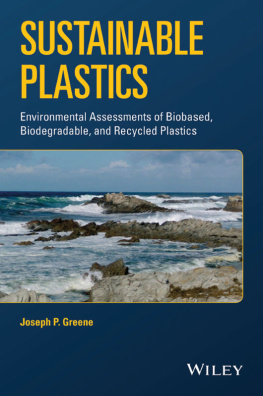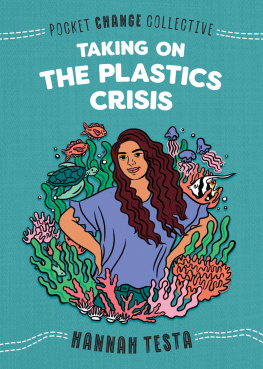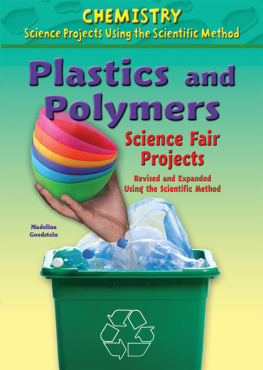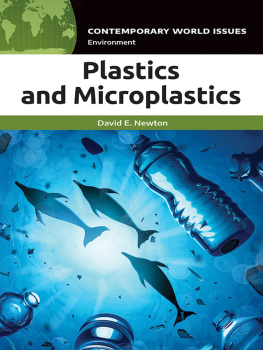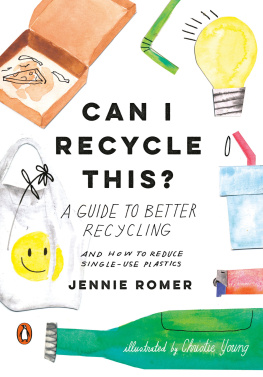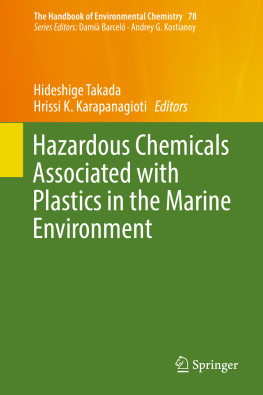
Sustainable Plastics
Environmental Assessments of Biobased, Biodegradable, and Recycled Plastics
Joseph P. Greene
Cover Design: Wiley
Cover Image: Courtesy of the author
Copyright 2014 by John Wiley & Sons, Inc. All rights reserved.
Published by John Wiley & Sons, Inc., Hoboken, New Jersey.
Published simultaneously in Canada.
No part of this publication may be reproduced, stored in a retrieval system, or transmitted in any form or by any means, electronic, mechanical, photocopying, recording, scanning, or otherwise, except as permitted under Section 107 or 108 of the 1976 United States Copyright Act, without either the prior written permission of the Publisher, or authorization through payment of the appropriate per-copy fee to the Copyright Clearance Center, Inc., 222 Rosewood Drive, Danvers, MA 01923, (978) 750-8400, fax (978) 750-4470, or on the web at www.copyright.com. Requests to the Publisher for permission should be addressed to the Permissions Department, John Wiley & Sons, Inc., 111 River Street, Hoboken, NJ 07030, (201) 748-6011, fax (201) 748-6008, or online at http://www.wiley.com/go/permission.
Limit of Liability/Disclaimer of Warranty: While the publisher and author have used their best efforts in preparing this book, they make no representations or warranties with respect to the accuracy or completeness of the contents of this book and specifically disclaim any implied warranties of merchantability or fitness for a particular purpose. No warranty may be created or extended by sales representatives or written sales materials. The advice and strategies contained herein may not be suitable for your situation. You should consult with a professional where appropriate. Neither the publisher nor author shall be liable for any loss of profit or any other commercial damages, including but not limited to special, incidental, consequential, or other damages.
For general information on our other products and services or for technical support, please contact our Customer Care Department within the United States at (800) 762-2974, outside the United States at (317) 572-3993 or fax (317) 572-4002.
Wiley also publishes its books in a variety of electronic formats. Some content that appears in print may not be available in electronic formats. For more information about Wiley products, visit our web site at www.wiley.com.
Library of Congress Cataloging-in-Publication Data:
Greene, Joseph P., 1961
Sustainable plastics : environmental assessments of biobased, biodegradable, and recycled
plastics / Joseph P. Greene.
pages cm
Includes bibliographical references and index.
ISBN 978-1-118-10481-1 (hardback)
1. Biodegradable plastics. 2. PlasticsRecycling. 3. PlasticsEnvironmental aspects.
4. Green chemistry. I. Title.
TP1180.B55G7435 2014
668.4dc23
2013051271
Preface
Plastics are one of the greatest inventions of the twentieth century. Plastics enable products to be made that meet the needs of the public for plastic applications. Plastics make life easier for all of us. We can purchase food, drink, and consumables in safe, lightweight, and clean containers and packaging made from plastic. We can drive around or be transported in a vehicle that is comfortable, pleasing to the eye, and safe thanks in part to plastics. We can communicate with small electronic devices that keep us connected with one another and also help entertain us with real and fantasy worlds.
Plastics are lightweight and easily thrown away with other heavier debris. Plastics can be recycled and reused many times. However, the lightweight benefits of plastics can cause them to be airborne and difficult for waste management companies to collect and dispose them off in landfills or other disposal environments. The lightweight plastics can occupy large volumes of landfills and can be a litter problem for land and sea. Floating plastics debris might be the final legacy of our disposal-society generation. Through education and training we can help our younger people become the sustainable generation. We can educate them in the ways of producing products and services with reduced environmental impacts. Products and services can be created with minimal waste, greenhouse gases, and pollution. This book can help provide information on creating lightweight and sustainable plastic products for our sustainable world.
Bioplastics today can be made from corn, soy, sugarcane, potato, or other renewable material source. Petroleum plastics can also be sustainable if they are made from renewable or recycled material sources. The manufacturing process also can also be sustainable. Plastics have the opportunity to define sustainable materials that are made from renewable or recycled materials sources, made with lower energy, produce less pollution, and have a low carbon footprint. Sustainable plastic materials also are recycled or composted at the end of the product service life. This book will define sustainability and sustainable materials and provide practical examples of sustainable plastics and provide examples of life cycle assessments (LCA) for these materials. This book can be used for education and training for plastics professionals and students who are interested in creating sustainable products.
Sustainable plastics can include biobased, biodegradable, and recycled plastics. LCAs will be used to provide a scientific explanation of sustainable plastics. The content of the book includes definitions of sustainability and sustainable materials, evaluations of the environmental concerns for industry, definitions of life cycle assessments, explanations of biobased and recycled plastics, and examples of sustainable plastics as defined by LCAs.
The author would like to thank Ms. Vanessa Vaquera for providing the artwork in the book.
Dedication
The author would like to dedicate this book to Dr. James O. Wilkes, Chemical Engineering Department, The University of Michigan, Ann Arbor, MI.
Glossary
ACC
American Chemistry Council
AHA
Alpha hydroxyl acid
AMS
Accelerator Mass Spectrometry (ASTM D6686)
ASTM
American Society for Testing Materials
BHET
(2-Hydroxyethyl)terephthalate
BOD
Biochemical oxygen demand (ISO 14851)
CFC
Chlorofluorocarbon
CO2eq
Carbon dioxide equivalent
DIN
German Organization for Standardization
DOE
Department of Energy
EOL
End-of-life
EPA
Environmental Protection Agency
GHG
Greenhouse gas
GPPS
General purpose polystyrene
GSI
Greene sustainability index
GWP
Global warming potential
HDPE
High density ethylene
HIPS
High impact polystyrene
LCS
Liquid Scintillation Counting (ASTM D6686)
IRMS
Isotope Ratio Mass Spectrometry (ASTM D6686)
ISBM
Integrated stretch blow molding
LCA
Life cycle assessment
LCI
Life cycle inventory
LDPE
Low density polyethylene
MEG
Mono-ethylene glycol
MRF
Materials recovery facility
MSW
Municipal solid waste
OPS
Oriented polystyrene sheet
PET
Polyethylene terephthalate
PGA
Poly glycolic acid
PHA
Poly-hydroxy-alkanoate
PHB
Poly-hydroxy-butyrate
PHBV
Poly-hydroxy-valerate
PLA
Poly lactic acid
POCP
Photochemical Ozone Creation Potential
PP
Polypropylene
PS
Polystyrene
PVC
Poly vinyl chloride
RDF
Refused derived fuel
USDA
United States Department of Agriculture
Next page
